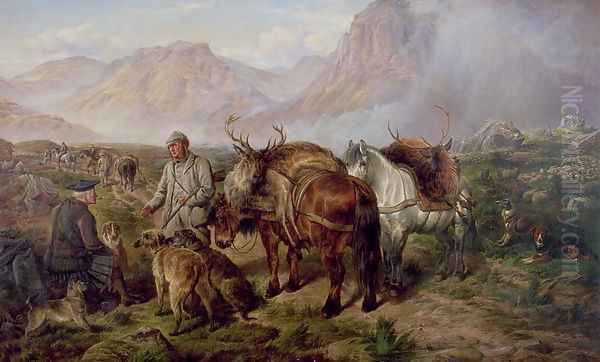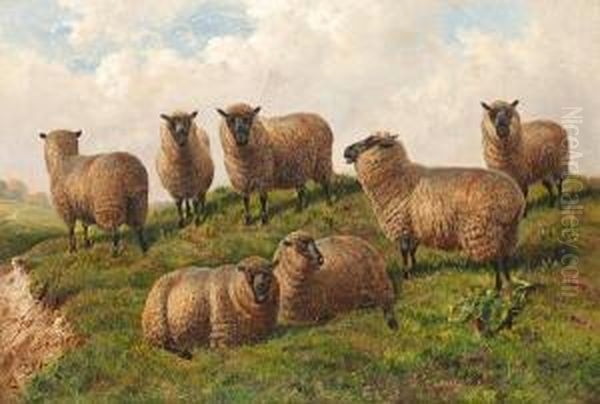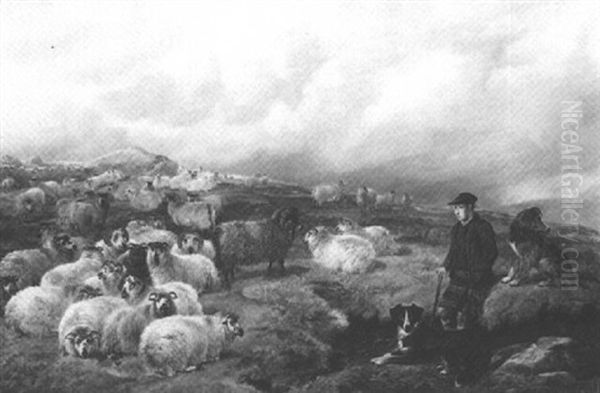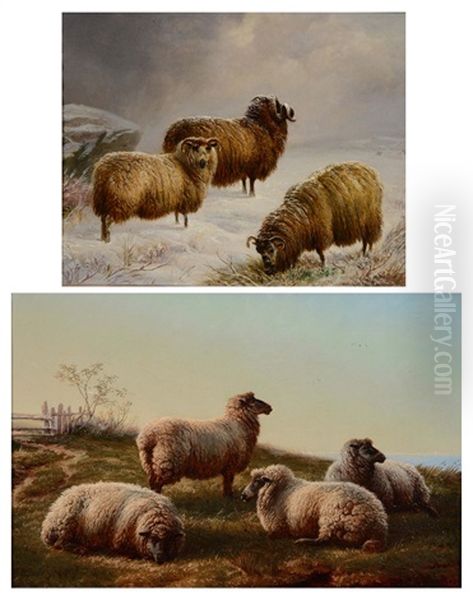Introduction: The Painter from Wales
Charles Jones, born near Cardiff in Wales in 1836, emerged as a distinctive voice in British art during the Victorian era. Active as a painter until his death in 1892, Jones carved a niche for himself, becoming particularly renowned for his sensitive and highly skilled depictions of animals within landscape settings. His affinity for portraying sheep, cattle, and deer with remarkable realism and empathy earned him the affectionate nickname "Sheep" Jones among his contemporaries and subsequent admirers. His work stands as a testament to the enduring appeal of pastoral scenes and meticulous observation in nineteenth-century British art.
Early Life and Artistic Grounding
While details of his earliest training remain somewhat scarce, it is known that Jones, hailing from Wales, sought artistic education in London, the vibrant heart of the British art world. A significant part of his formative experience involved time spent on a farm located in Berkshire. This period undoubtedly provided him with invaluable opportunities for close, sustained observation of farm animals and the rural environment. This direct engagement with agricultural life and its inhabitants deeply informed his artistic practice, laying the groundwork for the naturalism and authenticity that would become hallmarks of his paintings. His Welsh roots and subsequent immersion in the English countryside shaped his perspective and choice of subject matter.
Artistic Style: Realism and Empathy
The art of Charles Jones is characterized by its profound commitment to realism and its detailed execution. He possessed a remarkable ability to capture the textures of fleece, hide, and horn, as well as the anatomical accuracy of the animals he portrayed. Whether depicting a flock of sheep grazing peacefully on a hillside, cattle resting by a stream, or majestic deer in a Highland setting, Jones imbued his subjects with a sense of presence and quiet dignity. His skill was not merely technical; it reflected a deep understanding and appreciation of animal life and the natural world. This approach resonated with Victorian sensibilities, which often idealized rural life and valued verisimilitude in art. His meticulous technique allowed viewers to connect intimately with the scenes presented.
Focus on Fauna: Sheep, Cattle, and Deer

Jones dedicated much of his artistic output to the portrayal of sheep, cattle, and deer, often integrating them seamlessly into evocative landscapes. His nickname, "Sheep" Jones, points directly to his particular mastery in rendering these animals. He captured the characteristic behaviours and postures of sheep with an accuracy born of long study, depicting them not just as generic symbols of the pastoral, but as individuals within a flock. Similarly, his paintings of cattle convey their weight and placid strength, while his deer possess a wilder grace appropriate to their Highland habitats. This specialization set him apart and allowed him to develop a profound expertise within his chosen genre, contributing significantly to the tradition of animal painting in Britain.
A Career Exhibited: Recognition in London and Beyond
Charles Jones commenced his public exhibition career in 1860, marking the beginning of over three decades of consistent presence in the British art scene. He became a regular contributor to the prestigious Royal Academy of Arts in London, showing his works there almost annually until 1891. This long association with the RA, the premier exhibition venue of the time, indicates a sustained level of quality and acceptance by the art establishment. Alongside artists of diverse styles, from the Pre-Raphaelite works of John Everett Millais and William Holman Hunt to the popular landscapes of Benjamin Williams Leader, Jones found a place for his specialized art at the Academy.
Beyond the RA, Jones sought wider exposure for his paintings. He exhibited frequently at the British Institution between 1861 and 1883, another significant London venue known for showcasing contemporary British art. His work was also seen at the galleries on Suffolk Street (home to the Society of British Artists) and at the New Watercolour Society, suggesting his versatility in different media or his engagement with various artistic circles. Furthermore, his reputation extended beyond the capital, with exhibitions held at important provincial institutions like the Walker Art Gallery in Liverpool and the Manchester City Art Gallery, demonstrating a national reach for his appealing pastoral scenes.
Professional Affiliations and Accolades
Jones's standing within the artistic community was further solidified by his professional affiliations. He was elected a member of the Royal Cambrian Academy of Art (RCA), an institution dedicated to promoting art in Wales and with Welsh connections. This membership acknowledged his Welsh origins and his contribution to the arts. His skill and popularity also brought tangible recognition in the form of awards. Around the year 1890, towards the end of his exhibiting career, Charles Jones received a prestigious gold medal at an exhibition held at the Crystal Palace in London, a testament to the high regard in which his work was held even late in his life. Such accolades confirmed his status as a respected and accomplished painter within his field.
Representative Works: Capturing the Pastoral and the Wild

While many of his works focused on tranquil scenes of sheep and cattle in lowland pastures, one specifically mentioned representative painting highlights another facet of his oeuvre: Bringing Home the Deer. This work reportedly depicts a scene set in the dramatic landscape of the Scottish Highlands. It captures the aftermath of a successful hunt, showing the party returning with their quarry. This subject allowed Jones to combine his skill in animal depiction (the deer) with human figures and a rugged landscape, showcasing a narrative element alongside his naturalistic talents. Such works, along with his more common pastoral subjects, demonstrate his ability to evoke different moods and settings, from the peacefulness of the farm to the wildness of the Highlands.
Contemporaries and the Artistic Milieu
Charles Jones operated within a thriving, competitive, and interconnected Victorian art world. His specialization in animal painting placed him in a field populated by other notable artists. While the towering figure of Sir Edwin Landseer had dominated animal painting earlier in the century, Jones's career overlapped with artists like Thomas Sidney Cooper, who was particularly famous for his own detailed renderings of cattle and sheep, often in sunny Kentish landscapes. Richard Ansdell was another prominent contemporary known for animal and sporting scenes, sometimes collaborating with landscape painters.
Jones also shared exhibition spaces with artists focused on similar themes or broader landscape traditions. The detailed rural scenes of Myles Birket Foster, often in watercolour, shared a certain idyllic sensibility, though stylistically different. Later animal painters like Briton Rivière, known for his often dramatic and anthropomorphic animal subjects, were also part of the landscape Jones navigated. The tradition of animal painting continued with figures like John Frederick Herring Jr., son of another famous horse painter. Jones's consistent presence at major exhibitions meant his work was seen alongside the leading figures of the day, contributing to the rich tapestry of Victorian art.
Mentorship: Passing on the Skill
Beyond his own practice, Charles Jones also played a role in educating the next generation of artists. Two specific students are mentioned in relation to him: Thomas Matthews Rogers and Charles Fairfax Murray. Both individuals went on to establish their own careers in the art world, with Rogers becoming an artist and professor, and Murray achieving recognition as a painter, collector, and connoisseur, notably associated with the later Pre-Raphaelite circle. Jones's tutelage suggests a willingness to share his knowledge and skills, contributing to the continuity of artistic practice. This mentorship role adds another dimension to his professional life beyond his personal output and exhibitions.
A Posthumous Discovery: The Photographer

Intriguingly, the legacy of Charles Jones extends beyond his recognized career as a painter. Decades after his death, a significant body of photographic work attributed to a Charles Jones came to light. While some sources associate this photography primarily with a gardener of the same name working in the late 19th and early 20th centuries, other accounts link this photographic output directly to the painter Charles "Sheep" Jones. This discovery occurred long after his death, revealing a hidden aspect of his creative life. If indeed the work of the painter, it suggests a parallel artistic pursuit kept largely private during his lifetime.
The photographic style described is distinct: often simple, direct, and focused on capturing the form, volume, and texture of subjects, particularly plants, vegetables, and flowers. This contrasts with the more picturesque or narrative qualities of his paintings. The clean backgrounds and almost scientific clarity observed in these photographs prefigure certain modernist aesthetics, making their rediscovery particularly fascinating. This potential dual identity as both a popular Victorian painter and a proto-modernist photographer adds a layer of complexity and intrigue to his artistic profile, placing him in the company of other Victorian figures like Julia Margaret Cameron or Lewis Carroll who explored the photographic medium, albeit with very different aims and styles. The exact relationship between Jones the painter and Jones the photographer perhaps warrants further scholarly investigation.
Art Historical Position and Enduring Appeal
In the grand narrative of British art history, Charles Jones occupies a position as a highly competent and respected specialist painter within the Victorian era. He was not necessarily an avant-garde innovator who dramatically shifted the course of art, but rather a master craftsman working within established traditions of naturalism and animal painting. His nickname "Sheep" Jones aptly summarizes his primary contribution – the sensitive and realistic portrayal of livestock and deer within carefully rendered landscapes. His consistent exhibition record at major venues like the Royal Academy and his reception of awards like the Crystal Palace gold medal attest to his professional success and the esteem of his contemporaries.

His work satisfied the Victorian public's appetite for pastoral imagery, detailed realism, and scenes depicting the British countryside and its inhabitants. The continued appearance of his paintings at auctions and their presence in collections indicate an enduring market value and appreciation for his skill. While perhaps overshadowed by more famous contemporaries like Landseer or the leading Pre-Raphaelites, Jones maintained a successful career through dedication to his specific niche. The later discovery of the photographic work potentially adds a fascinating coda, suggesting a private, perhaps more experimental, side to his artistic vision. Ultimately, Charles Jones remains a significant figure for those studying Victorian animal painting and the broader landscape of 19th-century British art, admired for his technical proficiency and his empathetic connection to the natural world. His paintings continue to capture the imagination of viewers who appreciate finely observed depictions of animals and the enduring beauty of the rural scene.